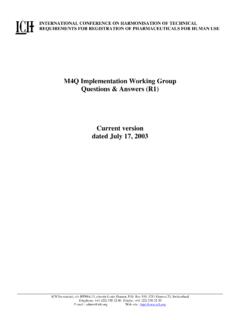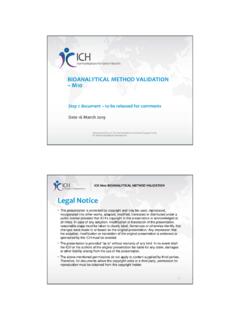Transcription of ICH guideline M10 Step2b on bioanalytical method validation
1 30 Churchill Place Canary Wharf London E14 5EU United Kingdom An agency of the European Union Telephone +44 (0)20 3660 6000 Facsimile +44 (0)20 3660 5505 Send a question via our website European Medicines Agency, 2019. Reproduction is authorised provided the source is acknowledged. 13 March 2019 1 EMA/CHMP/ICH/172948/2019 2 Committee for Human Medicinal Products 3 ICH guideline M10 on bioanalytical method validation 4 Step 2b 5 Transmission to CHMP 28 February 2019 Adoption by CHMP 28 February 2019 Release for public consultation 14 March 2019 Deadline for comments 1 September 2019 6 7 Comments should be provided using this template. The completed comments form should be sent to 8 9 10 11 12 INTERNATIONAL COUNCIL FOR HARMONISATION OF TECHNICAL 13 REQUIREMENTS FOR PHARMACEUTICALS FOR HUMAN USE 14 15 16 ICH HARMONISED guideline 17 18 19 bioanalytical method validation 20 M10 21 22 23 Draft version 24 25 Currently under public consultation 26 27 28 29 30 31 32 33 34 35 36 37 38 39 40 41 42 43 44 At Step 2 of the ICH Process, a consensus draft text or guideline , agreed by the appropriate ICH Expert Working 45 Group, is transmitted by the ICH Assembly to the regulatory authorities of the ICH regions for internal and external 46 consultation, according to national or regional procedures.
2 47 48 49 50 M10 51 Document History 52 53 Code History Date M10 Endorsement by the Members of the ICH Assembly under Step 2 and release for public consultation ( 54 55 56 57 58 59 60 61 62 63 64 65 66 67 68 69 70 71 72 73 74 75 76 77 78 79 Legal notice: This document is protected by copyright and may, with the exception of the ICH logo, be 80 used, reproduced, incorporated into other works, adapted, modified, translated or distributed under a 81 public license provided that ICH's copyright in the document is acknowledged at all times. In case of any 82 adaption, modification or translation of the document, reasonable steps must be taken to clearly label, 83 demarcate or otherwise identify that changes were made to or based on the original document.)
3 Any 84 impression that the adaption, modification or translation of the original document is endorsed or 85 sponsored by the ICH must be avoided. 86 The document is provided "as is" without warranty of any kind. In no event shall the ICH or the authors 87 of the original document be liable for any claim, damages or other liability arising from the use of the 88 document. 89 The above-mentioned permissions do not apply to content supplied by third parties. Therefore, for 90 documents where the copyright vests in a third party, permission for reproduction must be obtained from 91 this copyright holder. 92 93 ICH HARMONISED guideline 94 bioanalytical method validation 95 M10 96 ICH Consensus guideline 97 TABLE OF CONTENTS 98 1. INTRODUCTION .. 4 99 Objective .. 4 100 Background .. 4 101 Scope.
4 4 102 2. GENERAL PRINCIPLES .. 5 103 method Development .. 5 104 method validation .. 6 105 Full validation .. 6 106 Partial validation .. 7 107 Cross validation .. 7 108 3. CHROMATOGRAPHY .. 7 109 Reference Standards .. 7 110 8 111 Selectivity .. 8 112 Specificity .. 9 113 Matrix Effect .. 10 114 Calibration Curve and 10 115 Accuracy and Precision .. 11 116 Preparation of Quality Control Samples .. 11 117 Evaluation of Accuracy and Precision .. 12 118 Carry-over .. 12 119 Dilution Integrity .. 13 120 Stability .. 13 121 ICH M10 guideline 2 Reinjection Reproducibility .. 16 122 Study Sample Analysis .. 16 123 Analytical Run .. 16 124 Acceptance Criteria for an Analytical Run .. 17 125 Calibration Range .. 18 126 Reanalysis of Study Samples .. 19 127 Reinjection of Study Samples .. 20 128 Integration of Chromatograms.
5 20 129 4. LIGAND BINDING ASSAYS .. 21 130 Key Reagents .. 21 131 Reference Standard .. 21 132 Critical Reagents .. 21 133 22 134 Specificity .. 22 135 Selectivity .. 23 136 Calibration Curve and 23 137 Accuracy and Precision .. 24 138 Preparation of Quality Control Samples .. 24 139 Evaluation of Accuracy and Precision .. 24 140 Carry-over .. 25 141 Dilution Linearity and Hook Effect .. 25 142 Stability .. 26 143 Study Sample Analysis .. 27 144 Analytical Run .. 27 145 Acceptance Criteria for an Analytical Run .. 27 146 Calibration Range .. 28 147 Reanalysis of Study Samples .. 29 148 149 5. INCURRED SAMPLE REANALYSIS .. 30 150 6. PARTIAL AND CROSS validation .. 31 151 Partial validation .. 31 152 Cross validation .. 33 153 ICH M10 guideline 3 7. ADDITIONAL CONSIDERATIONS .. 33 154 Analytes that are also Endogenous Compounds.
6 33 155 Quality Control Samples .. 35 156 Calibration Standards .. 36 157 Selectivity, Recovery and Matrix Effects .. 36 158 Parallelism .. 37 159 Accuracy and Precision .. 37 160 Stability .. 37 161 Parallelism .. 37 162 Recovery .. 38 163 Minimum Required Dilution .. 38 164 Commercial and Diagnostic Kits .. 38 165 New or Alternative Technologies .. 39 166 Dried Matrix Methods .. 40 167 8. DOCUMENTATION .. 40 168 Summary Information .. 41 169 Documentation for validation and bioanalytical Reports .. 41 170 9. GLOSSARY .. 49 171 172 173 ICH M10 guideline 4 1. INTRODUCTION 174 Objective 175 This guideline is intended to provide recommendations for the validation of bioanalytical assays for 176 chemical and biological drug quantification and their application in the analysis of study samples. 177 Adherence to the principles presented in this guideline will improve the quality and consistency of 178 the bioanalytical data in support of the development and market approval of both chemical and 179 biological drugs.
7 180 The objective of the validation of a bioanalytical assay is to demonstrate that it is suitable for its 181 intended purpose. Changes from the recommendations in this guideline may be acceptable if 182 appropriate scientific justification is provided. Applicants are encouraged to consult the regulatory 183 authority(ies) regarding significant changes in method validation approaches when an alternate 184 approach is proposed or taken. 185 Background 186 Concentration measurements of chemical and biological drug(s) and their metabolite(s) in 187 biological matrices are an important aspect of drug development. The results of pivotal nonclinical 188 toxicokinetic (TK)/pharmacokinetic (PK) studies and of clinical trials, including comparative 189 bioavailability/bioequivalence (BA/BE) studies , are used to make regulatory decisions regarding the 190 safety and efficacy of drug products.
8 It is therefore critical that the bioanalytical methods used are 191 well characterised, appropriately validated and documented in order to ensure reliable data to 192 support regulatory decisions. 193 Scope 194 This guideline describes the method validation that is expected for bioanalytical assays that are 195 submitted to support regulatory submissions. The guideline is applicable to the validation of 196 bioanalytical methods used to measure concentrations of chemical and biological drug(s) and their 197 metabolite(s) in biological samples ( , blood, plasma, serum, other body fluids or tissues) 198 obtained in pivotal nonclinical TK/PK studies that are used to make regulatory decisions and all 199 phases of clinical trials in regulatory submissions. Full method validation is expected for the 200 primary matrix(ces) intended to support regulatory submissions.
9 Additional matrices should be 201 partially validated as necessary. The analytes that should be measured in nonclinical and clinical 202 studies and the types of studies necessary to support a regulatory submission are described in 203 other ICH and regional regulatory documents. 204 ICH M10 guideline 5 For studies that are not submitted for regulatory approval or not considered for regulatory 205 decisions regarding safety, efficacy or labelling ( , exploratory investigations), applicants may 206 decide on the level of qualification that supports their own internal decision making. 207 The information in this guideline applies to the quantitative analysis by ligand binding assays 208 (LBAs) and chromatographic methods such as liquid chromatography (LC) or gas chromatography 209 (GC), which are typically used in combination with mass spectrometry (MS) detection and 210 occasionally with other detectors.
10 211 For studies that are subject to Good Laboratory Practice (GLP) or Good Clinical Practice (GCP) the 212 bioanalysis of study samples should also conform to their requirements. 213 The bioanalysis of biomarkers and bioanalytical methods used for the assessment of 214 immunogenicity are not within the scope of this guideline . 215 2. GENERAL PRINCIPLES 216 method Development 217 The purpose of bioanalytical method development is to define the design, operating conditions, 218 limitations and suitability of the method for its intended purpose and to ensure that the method is 219 optimised for validation . 220 Before the development of a bioanalytical method , the applicant should understand the analyte of 221 interest ( , the physicochemical properties of the drug, in vitro and in vivo metabolism and 222 protein binding) and consider aspects of any prior analytical methods that may be applicable.













